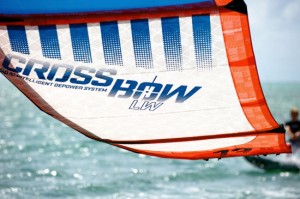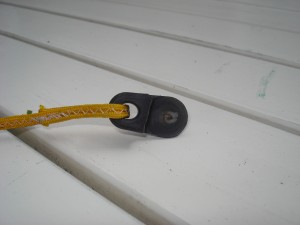THE 2012 CROSSBOW LW
The 2012 Crossbow LW is a performance free ride and a race kite that is used also for competition; it gives more power, range plus enormous advantage in boost to the kite surfer when combined with a long hang time. Also you can park and ride it in a simple way. The 2012 Crossbow LW has a different bridle with the transfer line from the rear lines to the front lines so changing direction will be lighter and easy. It is very fast to accelerate and once it is pointed in the new direction, zoom it off and it goes like a rocket!
18m 65
16m 60
13m 55
FEATURES
- 5 strut DESIGN
- Reduced Weight (Light Weight)
- Amazing Hang Time and Lift
- Tremendous Upwind Ability
- The biggest wind range in the lineup of Cabrinha
- Quick Link Control System with IDS
- Variable Tuning Options
- Designed for Sprinting
The 2012 XB have basically the same canopy shape and is still a BOW Kite. The bridle of a bow kite has been tweaked and has the outside line bridle circuit connected to the front line bridle circuit but in 2012 they have been separated.
As already mentioned the 13, 16 and 18 are considered Light Wind versions and have 5 struts instead of 7 with all the canopy material remaining the same. Initial feedback is that the 5 strut Light Wind version goes upwind better than its counterpart (2011 Crossbow), has more range, feels lighter in air hang time, improved turning, and the kite itself provides better loops.
PROS
– Provides more bridle configuration than the previous version
– Good turning speed with the new shape and bridle
– Re-launch is pretty much 100% dependent on the wind speed
If its super light condition as in the kite will barely fly and you are on the 18 or 16, and it may be tricky. As the wind rises up, it will turn to be easier. Another feature with regards to re-launch is keeping the kite light! This means reduction of parts and pulleys is recommended to make sure that the kite is as light as possible without giving away the important performance, re-launch or safety.
CONS
With the different shape of the Crossbow LW, it is found out that the benefit of connecting the front/rear bridles was not that evident, especially in the light wind versions. One thing to be noticed in particular was the bar pressure, especially on the 18 and 16 meter kites, too light will turn the bar pressure hard to handle and it will result difficulties on riding in super light winds.
CONCLUSION
The Crossbow LW is a breakthrough performance kite in the arena of light wind division. The Crossbow LW has reduced compact struts and a specific profile set to bring optimum performance when it is subjected for threshold winds conditions. Threshold winds are the speed of the winds where kite boarding becomes possible. The Crossbow LW not only allows you to ride when others are on the beach scratching their heads in surprise, but it provides the type of light wind efficiency to put you on the race stage in professional race events. Whether you are serious about light wind racing or serious about having fun in picky light wind conditions, the Crossbow LW is the kite for you. Also it is available in different sizes, bar and colors.
- 0 Comments
- Tags: 2012, cabrinha, Crossbow LW
Advantages of Bow Kites
12 Mar 2012 Author: crossbowkites In: Bowkites Bow kites also known as SLE kites are easy to recognize on their shape in form of a swept back flat profile with a concave trailing edge. The bow kites were designed by Bruno Legaignoux and Cabrinha Kites were the first manufacturer that started to construct kites with his design. Nowadays many other manufacturer are designing kites built on the bow concept, but with minor modifications.
Bow kites also known as SLE kites are easy to recognize on their shape in form of a swept back flat profile with a concave trailing edge. The bow kites were designed by Bruno Legaignoux and Cabrinha Kites were the first manufacturer that started to construct kites with his design. Nowadays many other manufacturer are designing kites built on the bow concept, but with minor modifications.
There are advantages and disadvantages with bowkites. The bowkites are not as fast turning as the C-kites which tend to turn around a pivot point, while bowkites turn more in an arc. So professional rides usually prefer C-kites, but bowkites are more suitable for beginners and intermediate riders that benefit from kites with lots of depower, easy relaunch and that can be used in a wider wind range. Most kiters need 3 kites to cover their quiver, but with bowkites a typical 75 kg heavy rider can form a good quiver with just 2 kites, a 7m and a 12m for kite instance which is equivalent to a wind range from 10 – 30 knots.
Bowkites are also good for handling gusty wind since they can deliver much depower.
Early bow kites suffered from problems such as unmanouverable when inverted, twitchy and not very stable, heavy bar pressure, difficult to water relaunch and harder to boost when jumping.
However year 2006 was a revolutionary year for the bowkites since some modifications to the bowkites made them much more high performance, safer, easier to relaunch, lower bar pressure and more unlikely to invert. 2006 was the year when the bowkites hade a huge boost on the market and modifcations over the past years have made them more popular than the C-kites. If you´re are new to kitesurfing and haven’t yet got you own equipment, then it´s really recommended to go for the bowkites.
Ride safe!
Some kite videos are nothing but just crap, but there are some rare videos that really kicks ass! This video shows some kitesurfers on a tour in Western Australia. The video is nice edited and they have made a good choice when it comes to the music. The video is almost 10 minutes long, but you don’t get bored after a minute. Well worth watching!
The music in the video comes in this order:
Easy Son – Hangman
March – The Disconnection (thedisconnection.com)
Below The Hour Glass – The Disconnection
At Night – The Disconnection
Compromise – Melodyssey
Break it – Spiral Soundsystem
And as you can see, they are riding the new Cabrinha Crossbow, thumbs up for that!
- 0 Comments
- Tags: 2012, Australia, cabrinha, crossbow, kitesurfing, Video
Broken pulley caused Cabrinha Crossbow to crash
19 Jun 2011 Author: crossbowkites In: 2009I had a session the other day with my Cabrinha Crossbow IDS 11m from 2009. The wind was about 20 knots. I made a small jump when suddenly a pulley broke. The kite started to loop and I totally lost the control over it. The water was deep and I did my best to wind up the lines on the bar in an attempt to reach kite. Unfortunately did I not manage to reach the kite before it was dragged up over some rocks with me after. I hit the rocks quite bad but luckily didn’t get injured except for some minor scratches and bruises. It went worse for the kite which not only got its foil tear apart but had its bladder punctured =(
I have Cabrinha kites from 2007, 2008 and 2009. I never had any problems with my older kites, but this Cabrinha Crossbow IDS from 2009 seems to be equipped with bad pulleys, this was actually the second pulley on the same kite that broke. The first time a pulley broke was during a simple air gybe transition, but things never turned bad that time and I had the pulley replaced with a new one. Now when a second pulley broke I kind of lost my reliance for this kite. I love Cabrinha kites and I have two other Cabrinha Crossbow kites from 2009, 9m and 13m, but they now feel a bit uncomfortable to ride with. What if another pulley breaks when I´m 5 meter up in the air, things can turn really bad…
Anyway, an email to the Cabrinha support was all that was needed to get a new pulley. Here is the answer I got from them:
We’re very sorry to hear about your pulleys breaking on you while riding. For future reference, the best option in any situation where the kite is not under your control (and your safety or those around you is being compromised), is to activate the IDS system by pushing QR1 away from your body. This should effectively flag the kite on the water so you can then determine the next best course of action.
We would recommend replacing ALL the pulleys on your kite. We’re happy to offer you a free 2011 replacement kit under warranty even though your kite is no longer within the normal covered warranty period. All you need to do is provide us with an address and cover the shipping costs with a valid credit card. The bridle lines are the same stuff we’ve been using since 2009 without any issues.
Also, we couldn’t open the file you attached for some reason. Either way, we can still offer you the replacement kit if you’re interested. The kite should perform normally once you install the new pulley kit.
- 4 Comments
- Tags: cabrinha, crossbow, pulley
Cabrinha Switchblade, great jumping kite!
9 May 2011 Author: crossbowkites In: CabrinhaHad a great kite session last weekend! It was sunny and blowing about 8-10 m/s, probably gusting around 12 m/s. My friend was standing in the water recording for our amateur kite movie that we plan to make this summer. Here’s one of my jumps over him 🙂
Override vs. Overslide
12 Apr 2011 Author: crossbowkites In: Bars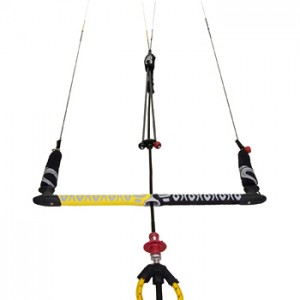 I´ve been riding Cabrinha kites for a few years. My first kite was 2007 Cabrinha Crossbow 9m, my second was a 2008 Switchblade 12m. Both kites are great and seem to be very sustainable, I used them a lot! The bars have started to become a bit worn out, that’s all.Recently I just bought three 2009 Cabrinha Crossbow in different sizes, partly since I needed new bars. I had a few sessions with them and there is nothing bad with the kites, but there is one very annoying thing with the bars, there are no s toppers! I used to love this feature with my old Cabrinhas, it’s very handy to be able to relax your arms by leaving the bar half way up on the throw and it was a great safety tool as well. If the kite got to much power for me to handle, then the bar simply passed off the stopper and depowered. With these new bars I really miss the stoppers, I almost regret my buy due to the absence of stoppers.
I´ve been riding Cabrinha kites for a few years. My first kite was 2007 Cabrinha Crossbow 9m, my second was a 2008 Switchblade 12m. Both kites are great and seem to be very sustainable, I used them a lot! The bars have started to become a bit worn out, that’s all.Recently I just bought three 2009 Cabrinha Crossbow in different sizes, partly since I needed new bars. I had a few sessions with them and there is nothing bad with the kites, but there is one very annoying thing with the bars, there are no s toppers! I used to love this feature with my old Cabrinhas, it’s very handy to be able to relax your arms by leaving the bar half way up on the throw and it was a great safety tool as well. If the kite got to much power for me to handle, then the bar simply passed off the stopper and depowered. With these new bars I really miss the stoppers, I almost regret my buy due to the absence of stoppers. To my surprise did I get a very detailed email back from the Cabrinha support. This is what they wrote:
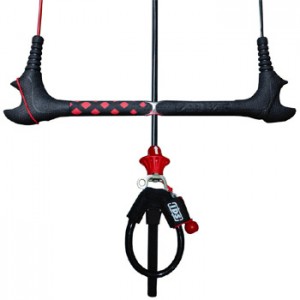 You may remember the Override 2 (from 2007 and 2008) was not included in the original 2009 shipments, we asked the market at the end of 2008 season if they wanted the OV2 in 2009, the overall feedback was to take it away because most good riders never used it and it could compromise safety in certain situations. Also the bar pressure is significantly lighter these days since there are no more 2:1 pulley bars, so we assumed nobody would really miss it.
You may remember the Override 2 (from 2007 and 2008) was not included in the original 2009 shipments, we asked the market at the end of 2008 season if they wanted the OV2 in 2009, the overall feedback was to take it away because most good riders never used it and it could compromise safety in certain situations. Also the bar pressure is significantly lighter these days since there are no more 2:1 pulley bars, so we assumed nobody would really miss it.We also needed to accommodate the IDS function to create the ability for maximum depower (5 line style depower with only four lines). Our goal is to reduce injury and death. We feel that we are a step closer with the IDS system. A by-product was a thicker depower mainline that would not allow us to use the OV2 sleeve.
Once we delivered the first few thousand IDS kites without OV2, we discovered that certain riders wanted it back. This came as a bit of a surprise since the markets we talked to said the majority of their riders were either riding without ever engaging it and many were taking the sleeve off completely to avoid any finger-skin pinching when sheeting the bar out.
Anyway – after hearing some of the initial requests from a few of our distributors, we then designed the retro fit system that you have now.
This new system does not work in the same way as previous versions. It is based on friction, not a mechanical system. Override IDS is designed to slide up the center line. The problem is most people expected it to disconnect and were confused with the sliding function. We did explain this in the new documentation as well as on our website, but it was not obvious enough. In retrospect, we should have called it OVERSLIDE, marketed it more and it would have been more obvious.
We decided that previous versions could be dangerous as in certain situations. With the 2008 version, you would need to physically push (fairly hard) though the stopper to activate the stage 1 depower. This was particularly true if a rider had the tension ring squeezed to the maximum setting and just let go of the bar. The kite would then not fully depower and the rider (and those around them) could be put in harms way. The Override IDS unit is safer because the rider is always able to safely push though to Stage 1 depower. It is one of the only true “let-go” safety systems currently on the market. This is very important to us since the kite needs to have the ability to depower by simply releasing the bar (in case a rider were to trip up and fall down while going out or coming into the beach). We believe this is the safest option for riders of any ability level.
Off the record: There are a few things you can do to alter the Override sleeve, but we can’t officially announce this. Any modifications will void any warranty as well.
Please note that the following are merely suggestions and while we’ve seen them done with varying degrees of success, we are not endorsing any of them as it can compromise your safety and ability to activate Stage 1 Depower.
We’ve seen riders reversing the Overide sleeve (taking it off and flipping it upside down). They then file down the two “nubs” on the tension ring to allow the ring to sqeeze tighter than designed. This combination seems to produce a higher degree of friction when releasing the bar. We’ve also seen riders using a cable-tie (otherwise know as a nylon zip tie) in place of the tension ring and tighten this up to a maximum. The most recent mod we’ve seen a few riders doing is altering the shape of the sleeve itself. This apparently involves removing the sleeve and putting it into a vice or simply clamping it with pliers. The vice is tightened to the point of closing the gap in the sleeve and then it’s heated gently to soften the plastic. This usually only takes 10 to 20 seconds using a heat gun. The sleeve is allowed to cool in this position. After a few minutes, the sleeve is re-installed and the modified / filed down tension ring is squeezed tight. This combination has been shown to increase the tension on the ring and create additional friction for the bar to rest against the sleeve with little to no movement up the depower tube. Please use extreme caution if trying any of these and be very familiar with your emergency quick releases should anything go wrong.
Hope this helps. Please do not hesitate to let us know if you have any additional questions. Lastly, there are no plans currently to return to an actual stopper system as we feel them to be quite dangerous in certain circumstances.
Best Regards,
Cabrinha Support
Cabrinha Crossbow IDS 10M
2 Apr 2011 Author: crossbowkites In: UncategorizedThis article is about Cabrinha Crossbow IDS 10M – 2009 edition.
AT A GLANCE
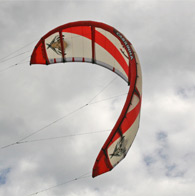 The Crossbow kite from Cabrinha has a long history in the pedigree of the bow kite. It was one of the first bow kites launched back in 2005 and over the last few years the design has been tweaked and the Crossbow has built a strong fan base. This year however the Crossbow has been taken back to the drawing board and had a complete redesign. So much has changed in fact it is hard to know where to start! First up the IDS bar is totally different, a simple 121 affair with no pulleys. It has fully moulded EVA bar ends, that are easy on the hands and also perfect for winding lines around. The set up utilises the Intelligent Depower System or IDS for short. This starts at the bar where a short IDS line is attached to the chicken loop. When you release the chicken loop, you’re still connected by the IDS line which runs just a few meters up the front lines. There is a secondary release to completely ditch the kite. There is more to the IDS than just an extra line though. The bridle on the Crossbow has been completely redesigned as well. Not only is it much shorter and simpler than before, but in incorporates two extra pulleys. These are part of the IDS and when it is engaged the bridle pulls on the kite from a more central point, similar to how a 5th line works. The result is still a bow kite, but it isn’t as flat as the previous year, in fact the profile changes with the sizes, the larger sizes having a flatter arc for better low end and extra efficiency and the smaller sizes having a rounder arc to aid control in high winds. Cabrinha call this the Dynamic Arc Progression and it means that every kite has been individually designed with the exact conditions in mind that you would expect to use that kite in.
The Crossbow kite from Cabrinha has a long history in the pedigree of the bow kite. It was one of the first bow kites launched back in 2005 and over the last few years the design has been tweaked and the Crossbow has built a strong fan base. This year however the Crossbow has been taken back to the drawing board and had a complete redesign. So much has changed in fact it is hard to know where to start! First up the IDS bar is totally different, a simple 121 affair with no pulleys. It has fully moulded EVA bar ends, that are easy on the hands and also perfect for winding lines around. The set up utilises the Intelligent Depower System or IDS for short. This starts at the bar where a short IDS line is attached to the chicken loop. When you release the chicken loop, you’re still connected by the IDS line which runs just a few meters up the front lines. There is a secondary release to completely ditch the kite. There is more to the IDS than just an extra line though. The bridle on the Crossbow has been completely redesigned as well. Not only is it much shorter and simpler than before, but in incorporates two extra pulleys. These are part of the IDS and when it is engaged the bridle pulls on the kite from a more central point, similar to how a 5th line works. The result is still a bow kite, but it isn’t as flat as the previous year, in fact the profile changes with the sizes, the larger sizes having a flatter arc for better low end and extra efficiency and the smaller sizes having a rounder arc to aid control in high winds. Cabrinha call this the Dynamic Arc Progression and it means that every kite has been individually designed with the exact conditions in mind that you would expect to use that kite in.
IN THE AIR
 Be prepared, the Crossbow IDS is a very different kite to the model the year before. Get excited though as it is different in a very good way. The Crossbow of old was always associated with a heavier bar pressure than most and while it was super stable and generated loads of power it wasn’t the fastest kite through the turns. This year the simpler bridle allows for a near direct coonection to the back of the kite which has livened up the steering considerably, add to that the 121 bar set up and you have a recipe for something altogether more exciting! Through the air the kite is very fast indeed and small movements on the bar will generate an instant response with the steering of the kite. This extra agility allows you to really move the kite aggressively around the window. This adds up to one thing that loads of free riders out there will love. Hangtime. The IDS is impressive to say the least and when it is powered it will rip you off the water with some force. That said the timings in the jumps take a little getting used to. Don’t be surprised if you get unceremoniously dumped on the first few attempts to get great height. Once dialled in the kite has some awesome
Be prepared, the Crossbow IDS is a very different kite to the model the year before. Get excited though as it is different in a very good way. The Crossbow of old was always associated with a heavier bar pressure than most and while it was super stable and generated loads of power it wasn’t the fastest kite through the turns. This year the simpler bridle allows for a near direct coonection to the back of the kite which has livened up the steering considerably, add to that the 121 bar set up and you have a recipe for something altogether more exciting! Through the air the kite is very fast indeed and small movements on the bar will generate an instant response with the steering of the kite. This extra agility allows you to really move the kite aggressively around the window. This adds up to one thing that loads of free riders out there will love. Hangtime. The IDS is impressive to say the least and when it is powered it will rip you off the water with some force. That said the timings in the jumps take a little getting used to. Don’t be surprised if you get unceremoniously dumped on the first few attempts to get great height. Once dialled in the kite has some awesome big air potential. In gusty conditions it handles very well, although the depower throw is now longer as the pulley bar has been dispensed with. So some of that finger tip control on the previous models has gone, but there is still plenty of control to be had. The IDS system works well too, simply activate the chicken loop and the kite comes down with no power. One thing that we noticed was the absence of a stopper ball, in previous years the Cabrinha system has been one of our favourites. We were surprised to see it missing this year and with such a long bar throw it was missed. But upon speaking to the guys at the head office the stopper is on the way and will be available to retrofit if you have one of the early kites.
big air potential. In gusty conditions it handles very well, although the depower throw is now longer as the pulley bar has been dispensed with. So some of that finger tip control on the previous models has gone, but there is still plenty of control to be had. The IDS system works well too, simply activate the chicken loop and the kite comes down with no power. One thing that we noticed was the absence of a stopper ball, in previous years the Cabrinha system has been one of our favourites. We were surprised to see it missing this year and with such a long bar throw it was missed. But upon speaking to the guys at the head office the stopper is on the way and will be available to retrofit if you have one of the early kites.
FOR
A completely different kite from last year, and one that is much improved. Loads of performance, fast to turn and guaranteed to excite you. The IDS system also makes the set up extremely safe.
AGAINST
Not having a stopper on such long bar throw was an issue, but this is being fixed as we speak. With 6 pulleys on the bridle you’ll want to ensure that you keep the clean and sand free to stop them from seizing up.
OVERALL
One of the best kites Cabrinha have put onto the market, completely different to the Crossbows of old, which were all great kites, but the new kite is faster, smoother and altogether more exciting to ride!
About Crossbow Kites
My first kite was a Cabrinha Crossbow kite, a so called bow-kite. The kite is from 2007 and still going strong! The kite is smashed in the water hundred times and the bar has been used so much that it's about to fall apart! Still the kite looks like brand new and it holds the air for days! The Cabrinha Crossbow is a great kite, but I tested many other bow-kites and they simply are the best and this site is dedicated to them!
